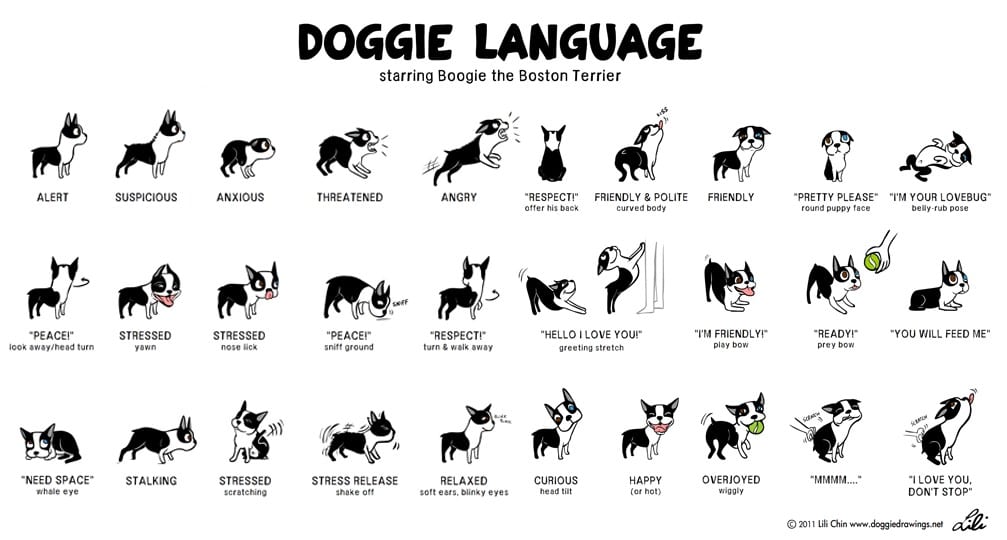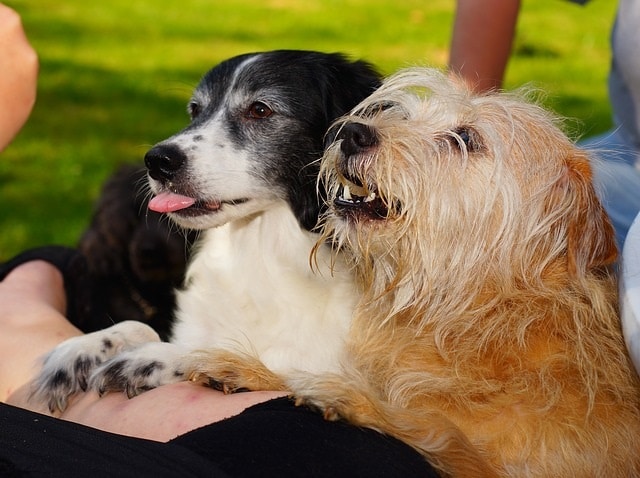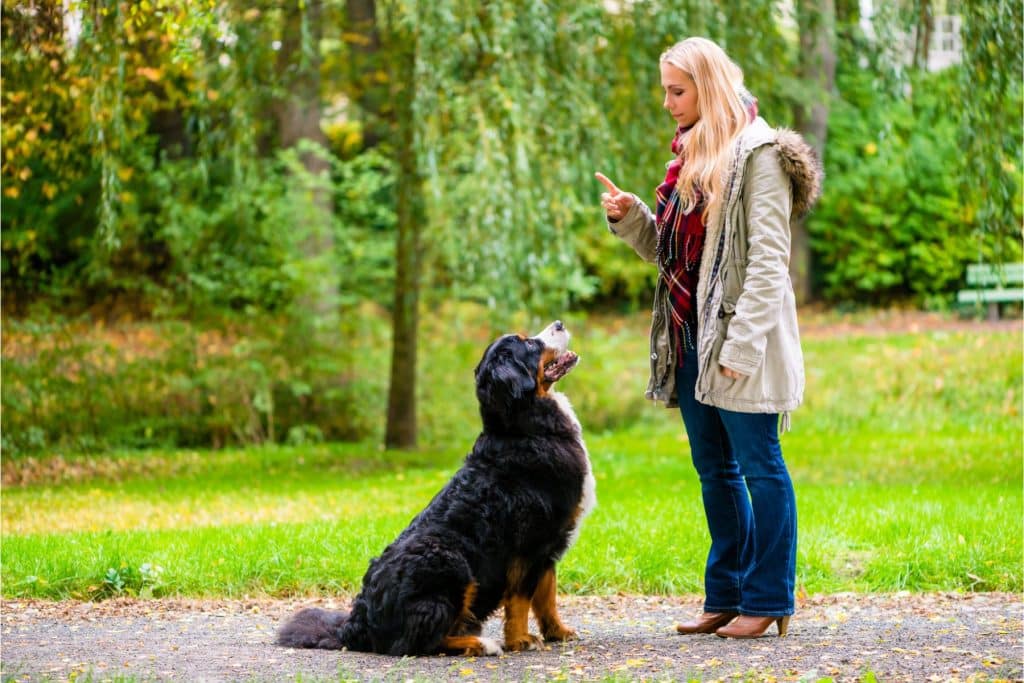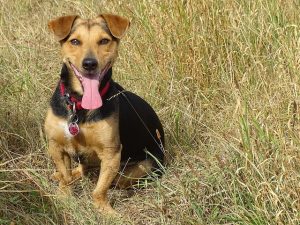This blog aims to give you some tips to deal with situations where an off-leash dog approaches you. Let’s paint you a picture first.
It’s a beautiful day, you are enjoying a walk with your dog, and then you spot another one – distant yet menacing. As it gets closer, you realize it’s not on a leash.
That gets you nervous and wondering what to do next. The fight or flight response starts kicking, but you remain indecisive. Situations like these never come with a warning, so before they catch you off-guard, I’ve got your back!
1. Determine the dog’s intent.
Not all dogs are aggressive. Many are rather calm and content.
However, you might be unlucky enough to run into an aggressive one. In that case, sensing the danger ahead of time might save you from unwanted injuries.
Decode the dog’s body language to determine its intent. The tail can give away important signs regarding the same. A wagging tail is an infallible sign of a happy and relaxed dog. On the other hand, a held-up tail signifies that the dog is alert.

This is just one of the many ways reading a dog’s body language can help you discover its intentions. For a detailed guide on a dog’s body language, check out canine behaviour charts.
Next, look for the owner. If you find their caretaker nearby, you can consider yourself on the safer side. If you don’t see any potential owner or caretaker, it’s time to take some precautionary steps.
Read More: 6 Signs That a Dog is Lost and What Should You Do
2. Keep calm and avoid sudden movements.
If you show signs of being afraid or surprised by the dog, you might trigger its predatory instinct. The adrenaline rush during such encounters is often the precondition for accidents. It’s pertinent that you stay composed and act smart.
Avoid sudden movements so as not to startle the dog accidentally and cause them to become aggressive. Many people would advise yelling “NO” or “SIT” in hopes that the dog is not a stray but a well-trained pet dog. Though, I believe the chances of being attacked by a well-trained dog are thin in the first place.
You can still yell to try your luck, but I suggest you keep “shout at the dog” only as a last resort.
3. Maintain your distance.
Maintaining your distance is the best way to deal with an off-leash dog. It’s simply a better option not to engage a potential threat. Dogs are creatures that love their personal space.
Although most pet dogs would likely not indulge in chases if you are only passing by, it’s still not a great idea to invade their personal space.
But what if it’s a narrow road and you have to get through anyhow? In such a scenario, I prefer to ensure my steps are slow and away from the dog’s tail.
4. Avoid triggering the dog’s aggressive instincts.
There have been times I have encountered unattended off-leash dogs during evening jogs, and I choose to walk past the dog when that happens. The short break from continuous running addresses both the dog and my exhaustion.
Running past dogs is generally bad because it cranks up their aggressive instincts and sets you up for an unwanted chase.
A general piece of advice I would like to share is that do not make your move based on statistics in such situations.
Certain dog breeds are statistically proven to be less aggressive than others, but it is not a great idea to contribute to the one per cent that could not make it past the seemingly calm neighbourhood dog.
A common mistake is to pick up a stick nearby and take an aggressive stance against the dog, further proving your hostility. Do not try to be violent with the dog because it has a better chance of hurting you.
5. Offer them treats.

Over the years, the dogs on my track downhill have recognised me and become friendly. A lot of this can be accredited to the little treats I give them every time I go on a run.
I can confidently confirm that every dog loves treats regardless of breed and size. I used to carry treats for my furry friends during jogs, and it was always rewarding to see them running towards me for snacks.
In case you are planning to do the same, I would suggest carrying something that has a mildly strong smell to it. But before giving away treats, you must ensure that the dog in question is a stray.
In my case, I was well aware that those were strays. Dog owners won’t be very happy about some stranger feeding their pet, and in some places, it is even considered a punishable offense to do so.
6. Call for help if needed.
If, god forbid, all your efforts to keep the threat off fail, and you get caught up in a situation where you desperately need a helping hand, you must call for help.
The best thing to do in such situations is to avoid all eye contact and phone the council switchboard to report the situation to the dog warden of your council. You must also call the police for immediate help.
If you are unaware of your local council and their contact number, enter your area’s postcode at https://www.gov.uk/find-local-council. It’ll give you a link to your local council’s website, which contains contact information, a portal to report incidents and much more.
What to do if an off-leash dog bites you?
Seek medical attention immediately if an off-leash dog bites you. Even if the bite doesn’t seem serious, it might become a breeding ground for infections. You’re better off getting it checked by a professional. Remember, prevention is better than cure.
Once you’ve seen a doctor, if the bite was minor and you don’t have any serious injuries, you can do a few things to help prevent infection.
First, wash the wound with soap and water. Then, apply a sterile bandage to the wound. Finally, monitor the wound for any signs of infection, such as redness, swelling, or discharge.
Additionally, try to remember the dog because the authorities might need it to check for rabies and other diseases carried by dogs.
You must contact a personal injury attorney if you suffer serious injuries from the bite or infection. An experienced attorney can help you recover compensation for your medical expenses, lost wages, and pain and suffering.
Should a dog be walked off-leash?

Generally, it would be best to walk only well-trained dogs without a leash. It has many benefits, such as increased exercise and mental stimulation for your dog. It creates a better bond between you and your furry friend. But it can become a hazard if your dog isn’t trained.
Some risks come with letting your dog off the leash. Even the best-behaved dogs can sometimes get distracted and run off, so it is important to ensure that your dog responds when called and stays by your side.
If other dogs are around, ensure they are friendly and unlikely to cause any problems. Avoid areas with a lot of traffic or wild animals that could scare your dog or cause them to run away.
Read More: How to train your puppy to wear a collar in one week?
Can you kick a dog if it attacks you / your dog?
You have the right to defend your dog and yourself against an off-leash dog. You can use whatever force to stop the attack, including kicking. However, you could be charged with animal cruelty if you kick a dog out of fear without any act of aggression.
If you choose to kick the attacking dog, aim for the nose or chest. These are the most sensitive areas and will be the most effective in stopping the attack.
Keep in mind, many professional dog trainers and behavioral experts say the secret to off-leash success is reinforcement – not punishment or reactvity. This doesn’t mean ignoring ‘bad’ behaviors like barking and lunging. Rather, it’s about committing to training and practice to reward positive off-leash interactions in a consistent and proactive way
Who is liable if an off-leash dog gets bitten by my dog?
Several factors come into play in determining liability, including the severity of the bite, the circumstances leading up to the bite, and whether or not the culprit dog was acting aggressively (see also ‘Here’s Why Your Dog Has Suddenly Turned Aggressive, And How To Fix It‘).
Generally, the dog’s owner that attacked will be held liable if an off-the-lead dog bites you or your dog. This is because, as the owner, you are responsible for your dog’s actions. However, there are some exceptions to this rule.
For example, if the off-leash dog acted aggressively and took reasonable steps to avoid the confrontation, you may not be held liable. Or, if the off-leash dog was on your property and you had put up signs warning about the presence of a dangerous dog, the owner of the off-leash dog may be held liable.
The best way to avoid leash violations and liability for dog bites is to pay attention to potential “leash laws” as well as “canine body language.” With practice and professional input, vigilance goes a long way in protecting you and your dog from safety risks and costly repercussions.





